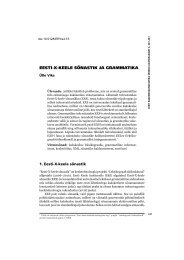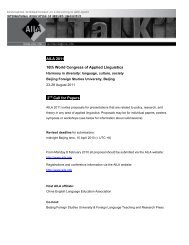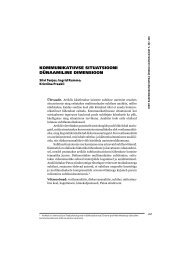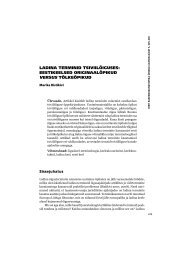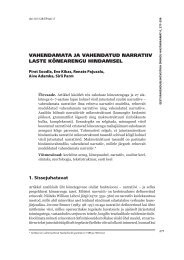ACQUISITION OF CASE IN LITHUANIAN AS L2: ERROR ANALYSIS
ACQUISITION OF CASE IN LITHUANIAN AS L2: ERROR ANALYSIS
ACQUISITION OF CASE IN LITHUANIAN AS L2: ERROR ANALYSIS
You also want an ePaper? Increase the reach of your titles
YUMPU automatically turns print PDFs into web optimized ePapers that Google loves.
2) inappropriate case form after a preposition. <strong>L2</strong> learners most often produce<br />
a correct preposition, but the case used with the preposition usually appears<br />
in a wrong form;<br />
3) inappropriate case form after a negated verb. In negative constructions<br />
students tend to use the accusative case instead of the genitive in the function<br />
of direct object;<br />
4) erroneous expression of time, location and direction. The concepts were<br />
confused especially in those students in whose native languages the expression<br />
of these meanings involves different formal constructions, i.e. case vs.<br />
prepositional phrase;<br />
5) confusing of words of different declension paradigms. The tendency of<br />
students using the right case form but a wrong declension type of a noun<br />
was observed especially with nouns belonging to different genders.<br />
When learning Lithuanian, <strong>L2</strong> students acquire the meanings of cases gradually.<br />
Therefore, errors are a sign of their progress. The results conrmed the hypothesis<br />
that students often rely on their native tongue and apply the translation model as<br />
a learning strategy. An impact of English as the language of instruction was also<br />
observed.<br />
The overgeneralisation strategy, especially in the use of the nominative, was<br />
observed in learning Lithuanian, and this supports the general learning tendency<br />
where the principle of analogy is applied for different contexts in rst and second<br />
language acquisition (Savickien" 2003b, 2006). Although no quantitative research<br />
was carried out, our study reects the tendencies of problematic use of the cases. The<br />
complicated process of the acquisition of case form and meaning has been observed<br />
in other case languages, such as Latvian, Russian, Polish, Greek, in rst language<br />
acquisition research (Ceytlin 1988, 1997, Christodou, Stephany 1997, R%&e-Dra vi'a<br />
1982, Smoczynska 1985, Stephany 1997, 1998, Voeikova, Savickien" 2001).<br />
These ndings bring more light on Lithuanian as a second language and show<br />
similarities and differences in L1 and <strong>L2</strong>. Moreover, it could suggest some applicable<br />
recommendations for <strong>L2</strong> language classes. The traditional method of teaching a<br />
grammatical rule and then applying it in grammatical exercises does not guarantee<br />
effective language learning. The importance of communicative competence and<br />
learning the form from the context should be emphasised more. Teachers should<br />
encourage students to identify grammatical tendencies rather than just to learn<br />
grammar rules by heart and drill them (Hinkel, Fotos 2002).<br />
62<br />
References<br />
Ambrazas, Vytautas (Ed.) 1994. Dabartin"s lietuvi( kalbos gramatika. Vilnius: Mokslo ir<br />
enciklopedij( leidykla.<br />
Ceytlin, Stella 1988. Okazional’nye morfologi#eskie formy v detskoi re#i [The morphologically<br />
occasional forms in child language]. Leningrad: Gosudarstvennyj pedagogi#eskij<br />
institut imeni A. I. Gercena.<br />
Ceytlin, Stella 1997. Acquisition of possessive relations by a Russian child. – K. Dziubalska-<br />
Ko)aczyk (Ed.). Papers and Studies in Contrastive Linguistics 33. Pozna*: Adam<br />
Mickiewicz University, 51–58.<br />
Christodou, Anastasia; Stephany, Ursula 1997. The early development of case forms in<br />
the speech of a Greek boy: A preliminary investigation. – K. Dziubalska-Ko)aczyk



